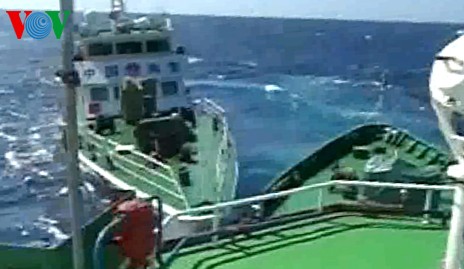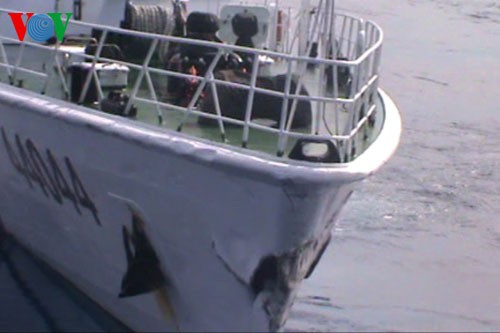(VOVworld) – In discussing China’s placement of oil rig Haiyang 981 on Vietnam’s continental shelf, lawyers and legal experts have presented much evidence and many arguments exposing China’s blatant violation of Vietnam’s sovereignty. They say China is intentionally misunderstanding the 1982 UN Convention on the Law of the Sea, UNCLOS, and using rationalizations to turn undisputed sea areas into disputed area in order to further its scheme to monopolize the East Sea.

Chinese ship directly hit Vietnamese marine police ship |
Article 57 of 1982 UNCLOS specifies that a country’s exclusive economic zone shall not extend more than 200 nautical miles from the baseline. Article 76 defines one method for measuring the breadth of a country’s continental shelf which mentions the distance of 200 nautical miles and mentions 3 other measurement methods which place the limit of the Continental Shelf beyond 200 nautical miles. Clearly China’s placement of oil rig Haiyang 981 119 nautical miles from Vietnam’s Ly Son island is totally within Vietnam’s continental shelf and exclusive economic zone.
Clear evidence of violation
Historical and legal evidence proves China’s violation. China says the oil rig is placed in China’s Xisha sea, which is in fact Vietnam’s Paracel archipelagos. China blatantly violated UNCLOS when it used force to occupy the Paracel archipelago in 1974. Doctor Nguyen Thi Lan Anh of the Diplomatic Academy of Vietnam said:“We all know that in 1945, after World War 2, the UN Charter was issued to maintain world peace and stability. It includes regulations that resolve disputes peacefully which are mandatory for UN members. UN member countries are prohibited from threatening or using force. But in the 1974 incident, China, a UN member, obviously breached the UN Charter. That illegal action cannot give China sovereignty in the Paracel archipelago.”
Vietnam has repeatedly confirmed that it does not acknowledge China’s sovereignty over the Spratly and Paracel archipelagos. The world has never recognized China’s sovereignty in this sea area. China’s sovereignty claim has no legal basis.

A Chinese ship broke its stem after thrusting a Vietnamese ship |
China has not only blatantly violated the sovereignty rights and jurisdiction of a coastal country over its exclusive economic zone and continental shelf but has also threatened freedom of navigation and regional peace and security. On May 5, China’s Maritime Safety Administration issued a statement banning ships from traveling within 3 nautical miles of the Haiyang 981 oil rig. Doctor Lan Anh elaborates. "By deploying various vessels and aircraft, China has violated the freedom of navigation of Vietnam and other countries. Reports from the area have said that when Vietnamese marine police ships were 7 to 10 nautical miles from the oil rig, they were attacked by Chinese vessels including military ships. The interference could happen to any ship traveling through the area. The East Sea is an important trade route and if any ship is obstructed from traveling there, it is a violation of the freedom of navigation."
Referring to all valid legal documents including the UN Charter, the 1982 UNCLOS, the International Convention for Preventing Collisions at Sea of the International Marine Organization, and agreements between China and ASEAN, China has ignored international law and violated the territorial sovereignty of its neighbor country.

China deploys missile vessel to protect its illegal oil rig on Vietnamese waters |
Rationalizing concepts
Lawyer Le Thanh Son said the placement of the oil rig Haiyang 981 on Vietnam’s continental shelf is another step in China’s scheme to gain a monopoly in the East Sea. By creating disputes, for example over the Philippine’s Scarborough shoal, China is trying to deceive the public into believing there is overlapping of the exclusive economic zones of regional countries. It’s part of China’s goal of making the U-shaped line its official border. Mr. Son said: "They cook up disputes where there is no dispute. Once there is controversy, they declare sovereignty. It’s a dangerous plot. They take advantage of the media to tell the world their oil rig is in a disputed area. Vietnam rejects this and insists that this is not a disputed area and that China’s action constitutes an invasion."
Vietnam resolutely defends its national sovereignty
Vietnam has all necessary legal and historical evidence to confirm its sovereignty over Hoang Sa and Truong Sa and jurisdiction over its exclusive economic zone and continental shelf under the 1982 UNCLOS.
To respect regional peace and development and the two countries’ relations, Vietnam insists on resolving the issue through peaceful dialogue.
What has China done to honor its commitment “to properly handle sea-related issues through friendly talks to make the East Sea a peaceful, friendly, and cooperative sea” according to the 6-point declaration signed by Vietnam and China in Beijing in 2011?
The answer is clear. The public awaits the next move by China.